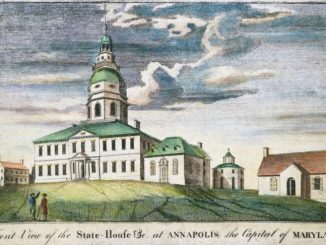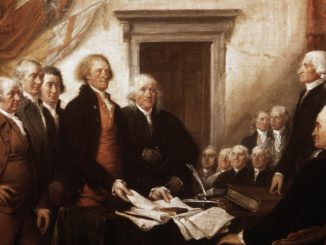Shays Rebellion was an uprising in Massachusetts that took place in 1787. It was in response to dire economic conditions after the Revolutionary War and Government indifference to the plight of rural Massachusettsans. Shays Rebellion highlighted deficiencies of the weak central government under the Articles of Confederation. As a result, many historians consider it a catalyst to the adoption of our current Constitution.
Economic Problems
In 1780, Daniel Shays retired from service in the Revolutionary War after he became injured. The Fledging United States of America operated at that time under the Articles of Confederation. This first effort to organize a Government in the new World gave almost no power to the Central Government. Although the Continental Congress managed the war efforts, States funded it through taxes. Some states paid none of the taxes due while others paid only part. As result, most soldiers were not paid the money they had been promised. Shays was no exception. Upon returning to his native Massachusetts, he discovered that he was being taken to court for debts he had no way to pay.
Around the same time Shays returned home, Massachusetts ratified a State Constitution. Rural communities across the state had rejected the document. There were onerous requirements for holding office and voting. As a result, the Legislature consisted almost entirely of Merchants from the wealthy Eastern part of the state. Rural residents saw the Government as elite, distant, and out of touch. This ratification added to the general distrust of the State Government.
Credit and Currency Issues
Shays was a resident of the part of Massachusetts which had an economy of subsistence. People bartered with each other for goods and services. In lean years local merchants would allow Farmers to purchase supplies on the promise of payment when things turned around. A few months after Massachusetts adopted its new constitution, the legislature also repealed the Tender Act.
Under the Tender Act, the Government and merchants were required to accept, at face value, the heavily devalued currency which the state printed. With the law no longer in effect, our European trading partners began to demand payment of debts in specie currency (gold and silver). The merchants had no choice but to pass these demands on to their customers. The problem was hard currency was in short supply. This created a Credit Crisis.
Adding to the problem, the State Government, eager to pay off the war debts it had incurred, increased taxes. Residents were being taken to court by the state and by creditors and having land and what few possessions they owned seized by collectors. Some were being sent to debtors’ prison. Animosity toward the merchant class, the courts, and the taxman grew.
Rustlings of Revolution
Job Shattuck, Like Daniel Shays, had fought in the Revolutionary War, rising as Shays had, to the rank of Captain. Mr. Shattuck was one of the largest landowners in the Groton Mass. area. Although he had the money to meet his taxes, he recognized that many of his fellow townspeople were being put in an untenable situation. In 1781 Shattuck and a group of residents harassed two different local constables to prevent them from collecting taxes. In one case this gang took back two oxen from a constable, returning them to the farmer.
No blood was shed and these actions barely rose to the level of protests. Reports of what happened were overblown and these became known collectively as the Groton Riots. The tiny uprising was quelled quickly. Shattuck and others were arrested. He paid a small fine and returned to his farm and his duties as a town leader. In a few years, he would rebel again.
After the trouble in Groton, and amid a general upheaval in rural communities, Governor John Hancock stopped actively seeking collection of the taxes due from the state’s poor. He also backed off on the requirement of hard currency for government debts.
Ongoing Protests
Although there was sporadic rioting over the next few years, residents mostly sought relief via petitions sent to the State Legislature. Among the requests from the residents was for the state to issue more paper money and to accept that as payment of debts, especially tax debts. The merchants stood to lose by Inflationary measures such as these, and so these petitions were ignored.
Among those in the legislature who were most vocally critical of the petitions was James Bowdoin. Bowdoin was a wealthy merchant who had been instrumental in drumming up support for the Revolutionary War, but who had been too sick to fight in it.
Bowdoin ran for the office of Governor several times but never came close to defeating John Hancock, who was widely popular. That is until 1785 when Hancock resigned the Governorship, citing poor health as his reason. In truth, it is believed that Hancock expected the trouble that followed.
Insurgency
Without Hancock to object, tax debt collection efforts were stepped up. Courts across the State were flooded with tax debt cases. A group of men calling themselves The Regulators set out on a mission to disrupt the courts. They hoped that by doing so they could keep the tax cases from being heard. Meanwhile, lists of grievances were drawn up at county conventions across the state. Residents carried these to the legislature.
Bowdoin was officially elected Governor in 1786 and set out to make matters worse. Taxes in Massachusetts were higher than they had been under British rule, but Bowdoin raised them further. He also again demanded payment in specie currency.
In August of 1786 when the Legislature ended its session without hearing the petitions, the rebellion took on a new fervor. Luke Day, another decorated former soldier, led approximately 1500 Regulators to Northampton and successfully kept the court from conducting business. In September, these men disrupted courts in five cities.
Mounting Pressure
Bowdoin called the actions treasonable. He pushed for legislation that made it illegal for more than a dozen armed people to gather. County Sheriffs were given permission to kill rioters without consequences. The legislature also passed a bill allowing leniency to those who would agree to leave the insurgent group. Few took them up on it. The Government even went so far as to suspend Habeas Corpus.
Warrants were issued for the arrest of several men known to be part of the group. Both Job Shattuck and Daniel Shays were among the ranks of The Regulators. In November of 1786 Job Shattuck suffered a serious gunshot wound while resisting capture. He was taken into custody and held without bail.
At some point, the rebels began to see Shays as a leader. Luke Day had more to do with the formation of the Regulators than either Shays or Shattuck. It is also said Day was more competent than Shays in many ways. But he wasn’t well-liked and many thought his overbearing religious beliefs got in the way. Also, Day had helped put down an earlier revolt against the unpopular State Constitution called Ely’s Rebellion. This led to the rebels considering Shays their leader rather than Day.
The Shaysites
It is unclear if Shays actually sought to be the group’s leader or if was putative. During a conversation with a fellow veteran, Shays allegedly said that he took leadership of the Regulators hoping to keep blood from being shed. In reality, the insurgents had many leaders. Still, the rebels become known as Shaysites
The insurgency took on a new intensity after a farmer was crippled when his family was attacked by a State militia. This also brought increased public support to the insurgency. Brigadier General William Shepard, expecting an escalation, sought permission to arm the militia. Permission was granted.
The Shaysites planned an attack on the Arsenal in Springfield, hoping to gain more weapons. In January Shays and about 1200 rebels marched toward that goal. Two other groups one led by Luke Day hurried to meet them.
General Shepard anticipated the move and his men were waiting with cannons full of grapeshot. Meanwhile, the army that Bowdoin had hired cut Days’ men off keeping them from reaching Springfield.
As the Shaysites approached, warning shots were fired over their heads and then Shepard opened fire. 20 men were injured, two died. The rest retreated. Days later Bowdoin’s private army routed them again and the Shaysites scattered. Shays and his wife fled to Vermont. After one final bloody skirmish between some remaining rebels and the Government militia later the same month, the insurgency was crushed.
Aftermath
Although some called for hangings as a deterrent, only two were actually hanged. Those two for burglary. Almost everyone who had taken part in the rebellion was pardoned eventually. Shays received his pardon after Hancock again won the Governorship. Shays returned to Massachusetts for a short time and then moved to New York where he died in 1825. He did finally receive a military pension.
It is not clear if the Shaysites have a long-term plan of action. Some believed they were intent on overthrowing the Government of the State and the Nation. Or, if that was not their intent, that people in other states would be bolstered to bring about the same sort of trouble. It was a wake-up call.
And The Impact
The shortcomings of a confederation of states with a weak central government had been discussed for some months. Shays Rebellion laid the weaknesses bare. The Continental Congress did not have the wherewithal, let alone the authority to stand against a group of rag-tag militant farmers, armed mostly with clubs and staves. Some historians dispute the importance of Shays Rebellion in moving the States towards drafting and adopting our Constitution which made us a Republic. Others say it was a pivotal set of events. Either way, it is hard to imagine this little short-lived farmer’s revolt did not have an impact on the content of the constitution.
Editor’s Note: For over 60 years, the marker on the grave of Daniel Shays was misspelled with the second “s” being omitted. Many recounts of history also misspelled his name. In 2016, a new grave marker was dedicated and the spelling mistake corrected. If you thought his name was “Shay” due to a long-standing error in some history records, you now know it was “Shays”.
For more articles by TFP writer, Shannon D. Hanson, https://thefoundingproject.com/forgotten-articles-confederation/ and https://thefoundingproject.com/articles-confederation-part-2-confederacy/.
Sources: https://www.britannica.com/event/Shayss-Rebellion; https://www.ushistory.org/US/15a.asp; https://www.masshist.org/object-of-the-month/may-2013; https://www.mountvernon.org/library/digitalhistory/digital-encyclopedia/article/shays-rebellion/#:~:text=A%20violent%20insurrection%20in%20the,states%20experienced%20similar%20economic%20hardships; https://allthingsliberty.com/2014/05/the-groton-riots-of-1781/; http://shaysrebellion.stcc.edu/shaysapp/person.do?shortName=james_bowdoin; https://www.founderoftheday.com/founder-of-the-day/job-shattuck; https://www.history.com/topics/early-us/shays-rebellion; https://www.thelcn.com/news/local/heroic-rebel-gets-his-s-new-gravestone-coming-for-formative-figure-in-u-s-history/article_06d2fba0-3c52-5c2b-9798-e18ad6a52382.html




Leave a Reply